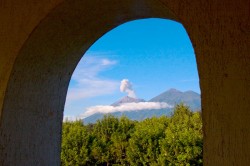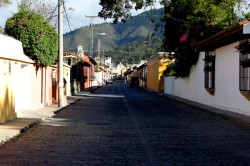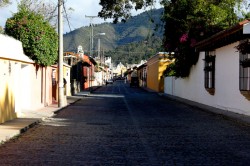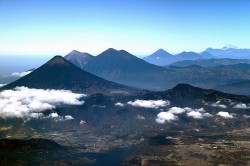 About Guatemala
About Guatemala
GOVERNMENT: A constitutional democratic republic with executive, legislative and judicial branches.
CAPITAL: The capital, Guatemala City, has a population of approximately 4.7 million in habitants. Antigua was the capital prior to the devastating earthquake of 1773. The capital was moved to the present location in 1776.
GEOGRAPHY: Its 42,000 square miles of diverse landscape ranges from towering mountains (which include 37 volcanoes – all waiting to be climbed) to low-land jungles, rain forest and crystal clear lakes and rivers. The altitude ranges from sea level to 13,000 feet.
POPULATION: The country has more than 15 million inhabitants. The Mestizos (descendants from the Indian and Spanish), who are a minority, have kept traits from both cultures and developed an identity of their own. Guatemala’s multicolor characteristics stem from the existence of more than twenty ethnic groups descended from the ancient Mayan inhabitants of the country.
 LANGUAGE: Spanish is the official language. In addition, some 23 autonomous dialects are spoken in highland regions.
LANGUAGE: Spanish is the official language. In addition, some 23 autonomous dialects are spoken in highland regions.
CURRENCY: The Guatemalan currency is the “Quetzal”. All major credit cards are accepted.
RELIGION: The majority of Guatemalans are catholic, although there is religious freedom. Among the different “ethnos” of the country, rituals that refer to the ancient gods of the Maya are still conserved.
CLIMATE: ” The Land of Eternal Spring” Guatemala enjoys a temperature of about 75°F (20°C) all year round. In the coastal areas and along the beaches, it may reach as high as 100°F. In the higher mountains, it can fall below freezing. It is advised that a visitor brings a sweater or a jacket for wear after the sun sets. The rainy season in the central highland – where Antigua is located – is from June to October when it showers mostly in the afternoons with sunny skies before and after.
ANTIGUA: The former capital of the country, declared by United Nations “Monument of the Americas”, 90 minutes from Guatemala City, with outstanding Spanish colonial buildings from the 16th century is an ideal place to learn the language.
 Antigua today is a beautiful colonial city where time has stopped. Walk the cobblestone streets where the baroque buildings are elaborately decorated. Guatemala treasures its colonial past. Primarily Spanish, its structures can be found in most major cities throughout the country. But nowhere can they be seen better than in Antigua, a colonial city which grew to be more beautiful than any other in Latin America.
Antigua today is a beautiful colonial city where time has stopped. Walk the cobblestone streets where the baroque buildings are elaborately decorated. Guatemala treasures its colonial past. Primarily Spanish, its structures can be found in most major cities throughout the country. But nowhere can they be seen better than in Antigua, a colonial city which grew to be more beautiful than any other in Latin America.
TIKAL: Some 2,500 years ago the Mayans began erecting the greatest civilization in the Western Hemisphere at Tikal, a city of towering temples, sophisticated stone dwellings, elaborate carvings and evidence of mathematical and astronomical excellence. The excavated ruins rise out of the jungle in Tikal National Park. Spider monkeys, jaguars and brilliantly plumed birds have inhabited the city since it was mysteriously abandoned by the Mayans in A.D. 900.
LAKE ATITLAN: 81 miles from the capital city, is one of the most beautiful natural sites. The lake is surrounded by three towering volcanoes and majestic mountains, its shores lined with colourful indian villages of descendants of the early Mayans. From first class hotels to the most economical ones make the town of Panajachel accessible to anyone.
 CHICHICASTENANGO: 90 miles from Guatemala City and 75 miles from Antigua, visitors make a point of being in this village on Thursdays and Sundays when Indians create a colourful market in the town square. Astute bargainers can get the best buys on woven fabric embroidered with myriad colourful designs, masks, and pottery. Santo Tomas church, founded in 1540, a mecca for mayans seeking guidance and favours from God, graces the square.
CHICHICASTENANGO: 90 miles from Guatemala City and 75 miles from Antigua, visitors make a point of being in this village on Thursdays and Sundays when Indians create a colourful market in the town square. Astute bargainers can get the best buys on woven fabric embroidered with myriad colourful designs, masks, and pottery. Santo Tomas church, founded in 1540, a mecca for mayans seeking guidance and favours from God, graces the square.
